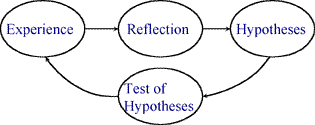|
DESIGN EFFECTIVENESS VERSUS INTENDED OUTCOMES
Apart from the issue of time taken to play the game, the design
works very well to achieve the outcomes. Students found the
make-believe effective in motivating them, and felt the desire
to make profits strongly. This gave them an impetus to achieve
the learning outcome.
HOW LEARNER ENGAGEMENT IS SUPPORTED
Engagement is the very basis of the design, which is provided
through the simulated production world.
ACKNOWLEDGEMENT OF LEARNING CONTEXT
The learning design is based on the learning context of higher
level undergraduate students in management. The design, assessment,
and the difficulty level are set around this context.
HOW THE LEARNING DESIGN CHALLENGES LEARNERS
Student feedback shows that the students found the learning
design very challenging, but the motivation was there to take
up this challenge.
OPPORTUNITIES FOR PRACTICE
The learning design provides practice in a simulated world,
and thus students get a feel for the uncertainty and financial
pressures of the practical world.
|
